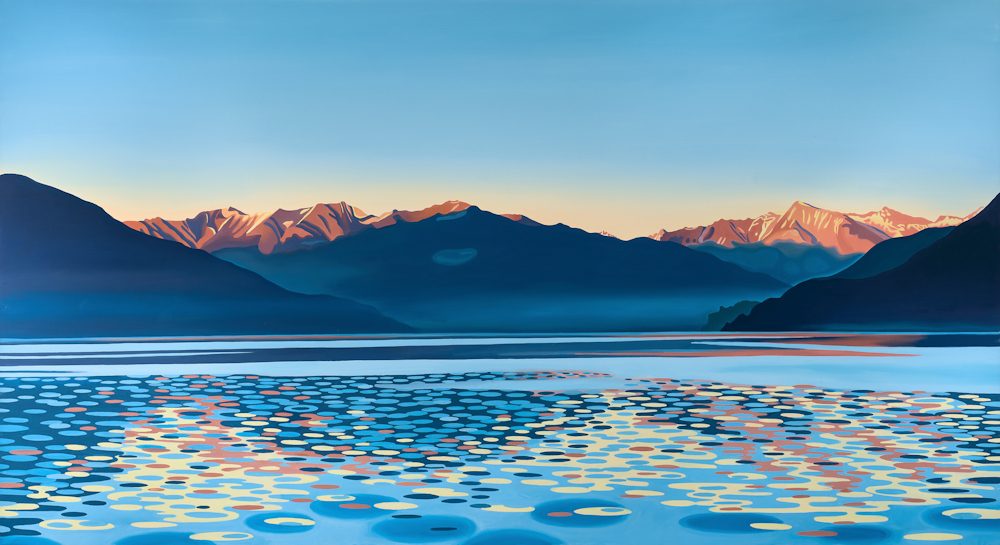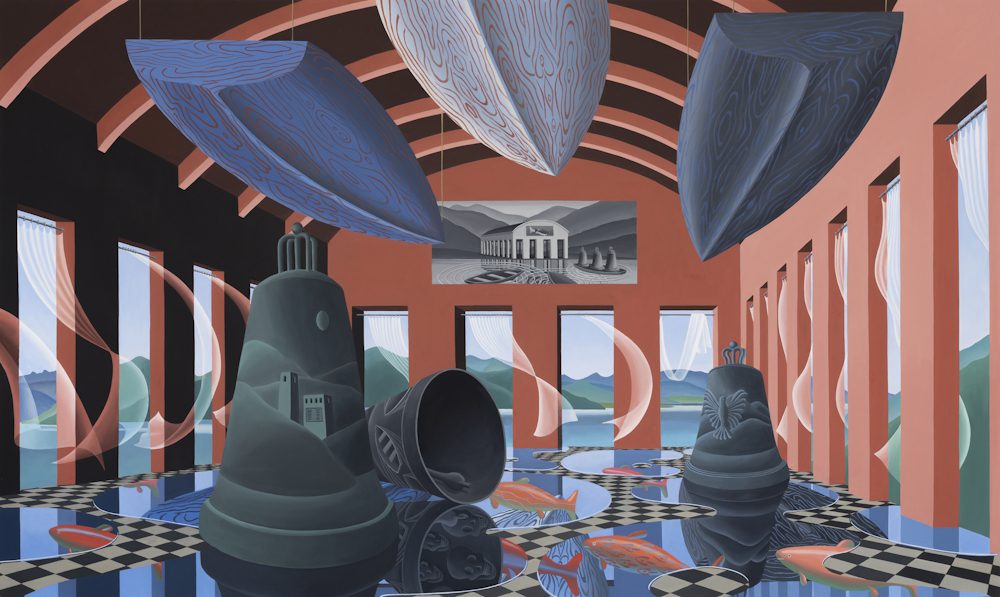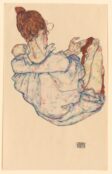Thomas Huber’s works express the immanence of spaces. Many of his earlier works contained rooms or architectural constructs that assumed both a distance from the viewer and a vivid space, creating their own contextual relations. The space is characterised by symbolic elements and positions that convey a separate reality, detached from our familiar associations. Examining his earlier works reveals the subjectivity of these settings. Different elements shape and serve as vessels of meaning, creating a clamour of dislocated moments, compelling closer inspection due to their distance from the viewer’s immediate position.
Huber’s movement from these earlier works, reminiscent of the brooding architectural sentiment in Giorgio De Chirico’s metaphysical works, towards his 2023 show Lago Maggiore marks a significant development. In the work Heimkehr (2021), we witness a continuation of his previous approach, which appreciates his new location around Lake Lugano. Huber has remarked that his works are intrinsically linked to the material, physical, and cosmological elements of the lake. Its light and the sensual movement of its surface are embodied in the artwork. However, the overarching symbolism of the elements signals the end of something, a death, while also alluding to something beyond.

The boathouse contains stylistic elements seen in Huber’s previous work, such as paintings within paintings—often symbolising the past or past events captured in the paint on canvas, contrasting with Huber’s dynamically created spaces suggesting the tumult of the present. Amidst this tumult, there are tools for escape: archways separating inside from outside, open windows, and inviting doorways. It might be glib to suggest that Huber’s work makes us feel as though we’re in an antechamber between the safe and the unknown, but it’s not entirely inaccurate. In “Heimkehr,” the painting on the wall depicts a boat approaching, carrying bells (signifying a death knell) into the ‘boathouse.’ The water on the floor reflects the inside of the bells, creating a sense of transition from a stagnant space to one where change is still possible. However, the interpretations drawn from their mirrored, ghost fish-containing, and reflective surfaces are immensely potent, potentially marking the end of one style of painting for Huber and heralding the next.


Arguably his greatest work to date, Heimkehr nonetheless offers vistas that form the bulk of this new series. Viewing this work as a starting point for more open depictions describing the luminous aspects of the lake and its surrounding mountains, the play of light within these natural confines is captivating yet somewhat confounding. Are the mountains a new form of containment? A more elemental spatial arrangement than the rooms and buildings he previously painted? Are they a vessel of water? To comprehend this new perspective on Huber’s spatiality, we might recall his thoughts on one of his vessel paintings from the 80s.

“Yes, here you have e. g. the bowl of water that is tilted so that the surface of the water inside the bowl widens, and this is done by sliding a bar of soap under the bowl so that the bowl tilts flat and the surface of the water increases. And that in turn is a kind of metaphor for the fact that pictures are also a way of enlarging the surface or our own surface – in order, as I called it at the time, to be able to snuggle up to the world with an even larger surface or more. To have receptivity. So the image is always also a membrane or an osmotic layer, which allows one to face the world with even greater contact. With a larger skin surface you could also say.” Thomas Huber (2020)
The lakes as vessels of water; a motif recurrent in many of Huber’s works. On this elemental level, there’s a connection between those mid-80s works and these depictions of sunlight on the lake’s surface as well as filtered through the moist atmospheres of cloudy skies. However, the removal of the geometric architectural elements is the most striking change. The viewer’s presence, previously established by a strong perspective, is now suggested by the title of the landscape works—a simple date supposedly marking when Huber completed his preparatory watercolours (included in the exhibition and stunning in their own right). These dates anchor the paintings to a specific human frame, our appreciation of time against which the natural scene is depicted. It places our situated presence within a cosmological moment when the sun’s position creates a lighted spatial surface within which we find ourselves.
“…my view of the image was always based on a very spiritual or spiritual content, so that the image, so to speak, retains itself from the material as much as possible.” – Thomas Huber (2020)
Taken at face value, the lakescape paintings are flat depictions of different light elements emphasising colour contrast relationships between different reflective bodies: lake, sky, and mountain. However, the meditative rhythm of these elements casts a spell beyond what might otherwise be considered somewhat banal postcard-esque subject matter. Huber finds a sense of mystery in these landscapes that calls us, much like the portals in his other work, into transcendent spaces.
The combination of Huber’s structural or Apollonian conceptual history and what might be seen as his Dionysian revelations in light and space over the course of this exhibition is exquisite. It’s a true reward for viewers wishing to be enticed into the antechambers between heart and head.

Exhibition notes:
Presenting seventy works including large oils and watercolours, the exhibition “Lago Maggiore” takes its name from a series of paintings by the Swiss artist Thomas Huber (Zurich, 1955). Huber, who is known for his intriguing, edge-of-reality paintings of architectural structures, rich in mise-en-abyme and drawing on a dream-like inner world, has long been based in Berlin, but since 2021 he has felt the need to return to the landscapes of his youth, taking a home on the Italian/Swiss border near Cannobio. The spectacular views of the lake from his home form the inspiration for the paintings in the exhibition. Like a sort of visual diary, the works explore the potentially endless variations on the same landscape, in which the mountains, water, sky and light are traversed by the natural rhythm of the seasons and the progression of the day. A celebration of the beauty and simplicity of the landscape, the paintings in this series represent an important new direction in Huber’s work: while retaining the vivid colours and well-defined shapes typical of his art, the large oils on show in MASI herald a significant departure from his previous practice. Built space and illusionary architectural forms make way for the elusive, powerful presence of the lake, captured from a specific angle and at specific times. Indeed many of the paintings are titled with their date of creation in the title, revealing the artist’s precise, almost scientific approach. This body of work thus takes up the idea of the series, which boasts many illustrious precedents in the history of art, such as those by Claude Monet, Paul Cézanne and Ferdinand Hodler.
Lago Maggiore, 8th October 2023 – 28th January 2024, Museo d’arte della Svizzera italiana, Lugano LAC Venue
References:
Huber, T. (2020). Art Cologne Talk: Wolfgang Ullrich and Thomas Huber. [online] www.youtube.com. Available at: https://www.youtube.com/watch?v=zhNtF6pTjRc&ab_channel=VernissageTV [Accessed 15 Nov. 2023].
Travel by Nicola Jeffs

Ex-London based reader of art and culture. Specialist subjects include; media, philosophy, cultural aesthetics, contemporary art and French wine. When not searching for road-worn copies of eighteenth-century travelogues he can be found loitering in the inspirational uplands of art galleries throughout Europe.




















